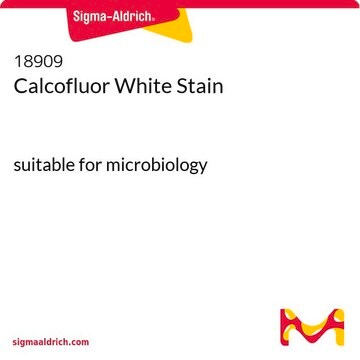As mentioned in the 'PROPERTIES' section, this product is supplied as a powder.
C6767
Congo Red
Dye content ≥35 %, Powder
Sinonimo/i:
Congo Red 4B, Cosmos Red, Cotton Red B, Cotton Red C, Direct Red 28, Direct Red R, Direct Red Y
Scegli un formato
Scegli un formato
About This Item
Prodotti consigliati
Nome del prodotto
Congo Red, Dye content ≥35 %
Stato
powder
Composizione
Dye content, ≥35%
tecniche
titration: suitable
Colore
red-brown
pH
6.7 (10 g/L)
Punto di fusione
>360 °C (lit.)
Solubilità
H2O: 1 mg/mL
applicazioni
diagnostic assay manufacturing
hematology
histology
Temperatura di conservazione
room temp
Stringa SMILE
[Na+].[Na+].Nc1c(cc(c2ccccc12)S([O-])(=O)=O)\N=N\c3ccc(cc3)-c4ccc(cc4)\N=N\c5cc(c6ccccc6c5N)S([O-])(=O)=O
InChI
1S/C32H24N6O6S2.2Na/c33-31-25-7-3-1-5-23(25)29(45(39,40)41)17-27(31)37-35-21-13-9-19(10-14-21)20-11-15-22(16-12-20)36-38-28-18-30(46(42,43)44)24-6-2-4-8-26(24)32(28)34;;/h1-18H,33-34H2,(H,39,40,41)(H,42,43,44);;/q;2*+1/p-2/b37-35+,38-36+;;
IQFVPQOLBLOTPF-HKXUKFGYSA-L
Cerchi prodotti simili? Visita Guida al confronto tra prodotti
Categorie correlate
Applicazioni
- Congo red has been used as a histochemical stain for the quantification of amyloid deposits in brain tissues.[1]
- It has been used as a cell wall inhibiting agent in fungus Cryptococcus neoformans.[2]
- It has also been used to study microstructural details in the cell walls of raw potato and fried potato using confocal microscopy.[3]
Azioni biochim/fisiol
Avvertenze
Danger
Indicazioni di pericolo
Consigli di prudenza
Classi di pericolo
Carc. 1B - Repr. 2
Codice della classe di stoccaggio
6.1C - Combustible acute toxic Cat.3 / toxic compounds or compounds which causing chronic effects
Classe di pericolosità dell'acqua (WGK)
WGK 3
Dispositivi di protezione individuale
Eyeshields, Gloves, type P3 (EN 143) respirator cartridges
Elenchi normativi
Forniamo informazioni su eventuali restrizioni prevalentemente per i prodotti chimici. Per altre tipologie di prodotto siamo in grado di fornire soltanto informazioni limitate. Nessuna segnalazione significa che nessuno dei componenti è citato in un elenco. È dovere dell’utilizzatore assicurarsi che il prodotto venga impiegato in maniera sicura e a norme di legge.
EU REACH SVHC Candidate List
EU REACH Annex XVII (Restriction List)
Scegli una delle versioni più recenti:
Possiedi già questo prodotto?
I documenti relativi ai prodotti acquistati recentemente sono disponibili nell’Archivio dei documenti.
I clienti hanno visto anche
-
hello, I would like to ask about this product, is it a powder or solution? thank you.
1 risposta-
Utile?
-
-
What is the Department of Transportation shipping information for this product?
1 risposta-
Transportation information can be found in Section 14 of the product's (M)SDS.To access the shipping information for this material, use the link on the product detail page for the product.
Utile?
-
-
Why does the SDS for Congo Red list carcinogen as an OSHA hazard, (Section 2) but in Section 11 on carcinogenicity, it states that there is no component identified as a carcinogen?
1 risposta-
The reason that there is not an OSHA listing for carcinogens on most of SDS that have a hazard of a carcinogen hazard is because that section of the SDS is specifically for the OSHA regulated carcinogens, also referred to as the OSHA 13. Congo red at this time is not specifically called out as a carcinogen by the other 3 Organizations listed (IARC, NTP, ACGIH) either. Congo red is listed by the European Classification Labeling & Packaging (CLP) Regulation (which is a pretty definitive guide for hazard classification), as a carcinogen. No other organizations have had the time to classify this material at this time. This is why it is only listed as a carcinogen in section 2 and in section 15.
Utile?
-
Filtri attivi
Il team dei nostri ricercatori vanta grande esperienza in tutte le aree della ricerca quali Life Science, scienza dei materiali, sintesi chimica, cromatografia, discipline analitiche, ecc..
Contatta l'Assistenza Tecnica.








